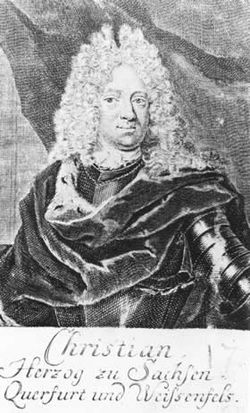- Christian, Duke of Saxe-Weissenfels
-
Christian, Duke of Saxe-Weissenfels (Weissenfels, 23 February 1682 – Sangerhausen, 28 June 1736), was a duke of Saxe-Weissenfels-Querfurt and member of the House of Wettin.
He was the sixth (but second surviving) son of Johann Adolf I, Duke of Saxe-Weissenfels, and Johanna Magdalene of Saxe-Altenburg.
Government of the Duchy
Christian inherited the Duchy of Saxe-Weissenfels after the death of his older brother Johann Georg without surviving male issue on 16 March 1712 and continued the policy of patronage and promotion of the sciences, education, and culture of his predecessors; in this tradition the created the Seminarium illustre in Weissenfels in 1716. His liberal spending, which far exceeded the resources of his small duchy, led to a complete financial collapse in 1719. To deal with the crisis, the Electorate of Saxony created a debit commission that controlled the finances of the duchy until its male line was extinct (both the duke and his brother had no male descendants). The commission was requested by the Emperor Charles VI of Austria; it substantially limited the duke's capacity to shape political policies.
Bach cantatas
For his 31st birthday in the year 1713, the composer Johann Sebastian Bach wrote the famous cantata Was mir behagt, ist nur die muntre Jagd, BWV 208 (The lively hunt is all my heart's desire) as occasional music with a pastoral character. It was performed in Weissenfels in the evening after a hunting party.
Christan is named four times in Salomon Franck's libretto for the cantata and equated with the classical deity Pan. The hunt is characterized as a high virtue and a privilege for princes to be able to enjoy.
It is probable that Bach wrote the piece at the request of his patron, Duke Wilhelm Ernst of Saxe-Weimar, to be used as a gift for Christian.
For Christian's 43rd birthday in 1725 Bach wrote the Shepherd cantata Entfliehet, verschwindet, entweichet, ihr Sorgen, BWV 249a (en: "Escape, disappear, disperse, ye sorrows"), its music is lost but survived as the parody setting of the Easter Oratorio.
Marriage and Succession
In Stolberg on 12 May 1712, Christian married Luise Christine of Stolberg-Stolberg-Ortenberg.
For this occasion, the Elector Frederick August I of Saxony, had the Weissenfelser Hunt Cup (de: Weißenfelser Jagdpokal) made as a gift for the couple. It was a costly and complex masterpiece of gold forging executed by the brothers Johann Melchior and George Christoph Dinglinger; it took as its artistic inspiration the duke's preference for the hunt. The cup stayed in the possession of the ducal house of Saxe-Weissenfels until it became extinct; after this, it again came into the possession of the Electorate of Saxony and can be admired today in the Green Vault (de: Grünes Gewölbe).
Christian's marriage was childless. Without heirs, he was succeeded on his death by his younger brother, Johann Adolf II.
Preceded by
Johann GeorgDuke of Saxe-Weissenfels
1712 – 1736Succeeded by
Johann Adolf IICategories:- 1682 births
- 1736 deaths
- House of Saxe-Weissenfels
- People from Weißenfels
- Dukes of Saxe-Weissenfels
Wikimedia Foundation. 2010.

